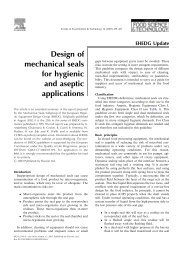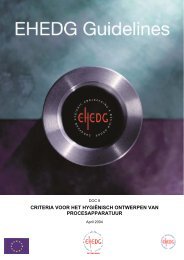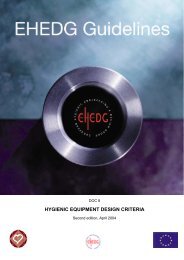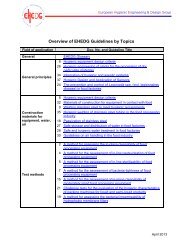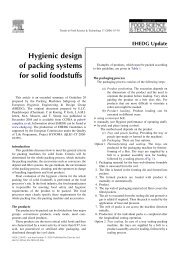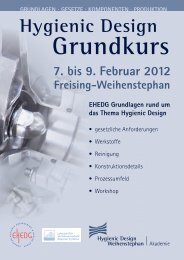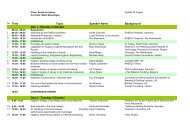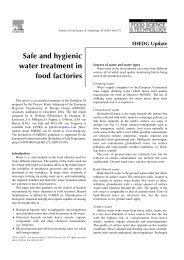Yearbook 2013/2014 - ehedg
Yearbook 2013/2014 - ehedg
Yearbook 2013/2014 - ehedg
You also want an ePaper? Increase the reach of your titles
YUMPU automatically turns print PDFs into web optimized ePapers that Google loves.
European Hygienic Engineering & Design Group<br />
Integrated hygienic tamper-free production<br />
The challenge for producers is to secure food safety in their production line, profitably. It is<br />
important to secure against operator mistakes, inconsistent product quality, and even against<br />
manipulation of the product. Adopting a holistic view on the entire production is the answer.<br />
Stefan Åkesson, Tetra Pak, Lund, Sweden, e-mail: stefan.akesson@tetrapak.com<br />
Today, production is integrated: The product flows continuously<br />
through the plant, from raw material intake to distribution,<br />
without stopping. This means that producers must control<br />
every step, both individually and as part of the whole.<br />
However, recurring problems with hygienic issues are<br />
reported from all over the world. Inconsistent food quality,<br />
manipulation of product, wilful tampering, human error – all<br />
of these reports have a huge impact on brands, profitability,<br />
and consumer confidence in the food industry as a whole.<br />
Securing tamper-free production is essential.<br />
Hygienic design<br />
It all starts with hygienic design. Hygienic design ensures that<br />
every material that will ever come in contact with food – from<br />
components right down to connections and welds – is designed<br />
and constructed for cleanability. Using and following the<br />
European Hygienic Engineering and Design Group (EHEDG)<br />
guidelines ensures state-of-the-art hygienic design. It is also<br />
important to conduct a hygienic risk assessment during the<br />
development and engineering phases of a project to analyse<br />
and evaluate hazards in order to eliminate or reduce hygienic<br />
risks. Following hygienic design principles means that the<br />
production process is designed with quality control functions<br />
that ensure food safety from start to finish.<br />
With quality assurance operations in place, substandard<br />
products can be handled at an early stage, which minimises<br />
product losses and increases product quality. One way<br />
to secure food safety is to use guidelines – structured<br />
procedures – as an important aid in the daily work of a food<br />
processing plant. Furthermore, the control system not only<br />
should monitor the procedures, but it should also actively<br />
provide hygienic functionalities that help the producer avoid<br />
operator mistakes, ensure quality control and secure a<br />
tamper-free production environment.<br />
To assist the producer’s food safety management system,<br />
it is important that the quality control system monitors the<br />
implementation and attainment of good manufacturing<br />
practices (GMP) and identifies measures to correct any<br />
failure to achieve GMP.<br />
Integration of hygienic, aseptic and control systems is shown<br />
in EHEDG Guideline 24.<br />
Tamper-free production solution<br />
Advanced control systems with recipe handling, production<br />
monitoring and production analysis access information<br />
about the ongoing process. To secure consistent product<br />
quality and avoid intentional tampering, the optimal tamperfree<br />
solution should involve all phases of production, with<br />
multiple levels of security (e.g., automated material handling<br />
that secures the mixing accuracy, even of manual ingredient<br />
additions or monitoring of the cleaning sequence through<br />
clean-in-place [CIP] sensors, and automatic adaption of<br />
the cleaning procedure, depending on the information<br />
received and analysed). The control system also ensures<br />
that the product and cleaning agents are not mixed. In<br />
the warehouse, recipe handling functions should ensure<br />
that the right material and amounts are stored, and stock<br />
management should show continuous inventory information.<br />
The recipe handling also helps the operator to create the<br />
batches according to the recipe and production schedule,<br />
and a unique batch identification (ID) number is generated<br />
when ingredients are being prepared for different batches to<br />
ensure that the right ingredients and amounts are added into<br />
the right tanks (Figure 1).<br />
Figure 1. Cabinets containing the different ingredients have<br />
automatic locking system integrated with the recipe handling<br />
system. The operator is prompted by the system to add ingredients<br />
in a preset order, and through the cabinet locking system, the<br />
operator can pick only the correct mixture, securing product quality.<br />
Another security function is in the mixing area. A stock-inand-out<br />
solution is integrated with the weighing system and<br />
a scanner device that the operator uses to keep track of<br />
all additions. In the process area next to the mixing tanks<br />
the operator scans the generated batch ID barcode on the<br />
prepared bin and the barcode on the tank. If the codes<br />
match the automatic tank locking system the tank will open.<br />
The interlocking function makes sure that the right mix<br />
goes into the right tank. Locks on both tanks and ingredient<br />
containers secure the integrity of the system and this ensures<br />
consistent product quality while reducing waste and product<br />
loss. Another feature of an automated control system is the<br />
availability of reports: Batch reports, stock reports, journals



